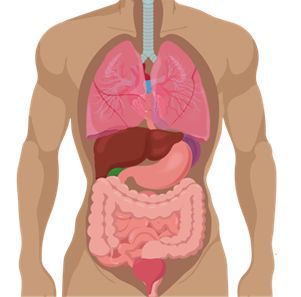Now we're gonna talk about the abdominal pelvic regions, the abdominal pelvic regions divide the abdomen, creating an imaginary tick tack toe board. So if we look at this model here to the right, we can see that on the abdominal pelvic region, there's these two vertical lines, there's these two horizontal lines creating a tic tac toe board or maybe a hashtag with the navel or the belly button kind of near the middle. Now, when you do that, that creates nine sections and we said that nine is more than four, the four quadrants that we learned for the abdominal pelvic quadrants. And for that region reason, the abdominal pelvic regions tend to be preferred by anatomists. They're more specific. These nine regions are named for their location and the naming follows a pattern. First, you wanna identify, are you talking about something that's on the right in the center or on the left? And that's because the left and right are gonna have terms that are different from the terms for the center. Next, those terms are gonna be based on whether they're located in the top, middle or the bottom. Now, I said previously, these can be a little bit harder to learn than the quadrants because these names are based on the Greek and Latin anatomical terms. Now, don't worry too much. You should already know some of these terms. So let's go ahead and take a look first off. We're gonna start on the right or left, right or left. You always start with right or left. So you're indicating the side and then on the top, we're gonna call that the hypo chondritic reason. Now, hypo means below and chori refers to the ribs. So hypo, even though it's at the top of the regions that we're talking about, we're talking about the space just below the ribs. Now, you've probably seen that word hypochondriac before referring to someone who thinks they're sick all the time, even though there's nothing actually wrong with them. There's a reason for that. A long time ago, we're talking hundreds of years ago, that condition where you think you're sick but you're not was start to ori was thought to originate in the hypochondriac region. So they thought there was something wrong with you just below your ribs over time, the name for that region got associated with the condition. So hypochondriac means somebody who thinks they're sick when they're not, but the term specifically means the place right under your ribs. So at the top of your abdominal pelvic region, you have your right and left hypochondriac region. If we go down, we reach the middle in the middle, we're gonna call the right or left lumbar. That should be familiar lumbar is your lower back, right, your lumbar region sort of right here. That's kind of in the middle, in terms of up and down of your abdominal pelvic region. So abdominal pelvic region in the middle, left or right lumbar region, finally, you reach the bottom, you have the left or right in inguinal that should also see be familiar l meant of the groin. So on either side, left or right inal region going down the middle, we have a different set of terms down the middle we have starting first, we have epigastric. Now, epi means above or on top of and gastric refers to the stomach or your intestine area. So above on top of your intestinal area is your epigastric region right there. In the middle going down, we have the umbilical umbilical is your naval or belly button, right? Your belly button is right in the middle. You should be familiar with that word, umbilical, right in the middle of your abdominal pelvic region. And finally, at the bottom, we have hypogastric. Well, we said gastric refers to the stomach or the digestive organs and hypo means below. So this is going to be below the stomach. So it's right in the middle, at the bottom of the abdominal pelvic region. So going through them all one more time, we have right or left hypochondriac region in the middle we have the epigastric region. We have the right or left lumbar region in the middle. We have the umbilical region. We have the right or left inguinal region in the middle. We have the hypogastric region. We're gonna practice this more in an example below and with practice problems to follow and I, we'll see you there.

